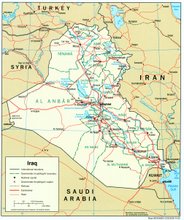Iraq's Sectarian Fallacy---"Fake News of Who is the Majority"
Since 2003, the various parties and coalitions installed as successive governments in Baghdad by the Bush Administration and backed by their Iranian patrons are "legitimized" by the fabrication that there was a Shia "majority" in Iraq.
One of the greatest lies perpetuated to justify the 2003 invasion besides the fake "weapons of mass destruction" argument was the sectarian demographics of Iraq.
The Sunnis in Iraq consist of Arabs, Kurds, and most of the Turkoman communities. The Shia populations in Iraq is primarily Arab, but also include small Persian, Kurdish, and Turkoman communities.
To justify the sectarian politics, Sunnis were divided up into two primary ethnic groups: Sunni Arabs and Sunni Kurds. However the Shias were kept as one ethnic/religious group.
Even so, with the Arabs and Kurds together, the Sunnis comprised of 58% majority of the population. Without the Kurds, the Sunni Arabs still have slight majority although it can be said the Arab Sunnis and Arab Shia are very close in number.
Here are hard numbers of the demographics of Iraq. According to the UN-approved Iraqi official census (which was approved by the US representative in the UN) which was submitted to distribute the food rations under the "Oil for Food" program in 2003, the population of Iraq was as follows:
The total number of people was 27,475,167 Iraqis
The religious minorities included 334,488 Christians (1%) and 281,984 Yazidis (1%).
The population was broken down by province:
If only the Arab provinces are included (without Kurdistan), the Arab-Sunni/Shia makeup is close to equal: 50% Sunni to 48% Shia in accordance with the provincial makeup (most of the predominately Sunni provinces have higher concentrations of populations than the predominately Shia provinces).
However if we add the Kurdistan provinces which are primarily Sunni, the percentages would be 58% Sunni and 40% Shia.
Using the "fake majority" argument as justification, Iranian-backed religious parties and militias aligned with the Bush Administration in 2003, abolished the existing Iraqi institutions and replaced them with mafia-like replacements controlled by these militias and mob-like parties.
One important example was the Iraqi Army, which was established by the British in 1921 after World War I, consisting primarily of former Ottoman Army officers. The same Iraqi Army established in 1921 continued throughout the mandate period (1921-1932), the Hashemite Monarchy (1932-1958) and throughout the Republican periods under Qassem, Arefs, Bakr, and Saddam (1958-2003). Even though the leaders and forms of governments drastically changed from one period to another, the army remained as a professional institution and represented all facets and denominations of Iraq, because of the mandatory conscription of all young men. That conscription guaranteed that all religious and ethnic groups in Iraq were adequately represented in accordance with their actual numbers in Iraqi society.
The Bush-appointed ruler of Iraq in 2003, Paul Bremer, who had previously worked for Henry Kissinger at his Kissinger Associates firm, decided to abolish this national professional institution and replace it with militiamen from these religious sectarian groups who had a violent past and agenda to start a civil war, which they later did.
The new army was no longer representative of Iraqi society because the conscription was also abolished and now had only one sectarian identity and one goal--a religious virulent anti-Sunni agenda. It would be analogous to, if the US Army is one day abolished and replaced with paramilitaries from the Ku Klux Klan (KKK)---that would be a nightmare in America, especially for ethnic and religious minorities, if that ever happened....but that's what happened in Iraq in 2003.
As a result of these failed policies, millions of Sunnis have been expelled from their homes throughout the country since 2003, and hundreds of thousands have been either killed or still languish in jails, most without trials or access to any judicial process.
And to this day, the Shia religious parties control the Prime Minister's office, the Army, the Internal Security services and most of the government positions. The military is reportedly over 90% Shia. In addition, the militia-government also created a new all-Shia "Popular Mobilization Militia" to include as a government-sanctioned paramilitary umbrella group along with the Army to supposedly fight ISIS; probably because the newly created 2003 army was so corrupt and inept that they fled from the battlefield in 2014.
Even so, it is fair to say that these sectarian political parities have done nothing for the Iraqi population, neither Shia nor Sunni. The predominantly Shia areas still suffer from the lack of infrastructure projects, lack of basic services like electricity, proper clean water, sewage treatment, road infrastructures, and manufacturing. Gasoline and electricity is outsourced to neighboring Iran to please the militias' patrons. And that's why demonstrations erupted in October 2019 in the predominately Shia areas. Previously in 2011 and 2012, millions of Iraqis in the predominately Sunni areas went out in mass demonstrations but the militia-led government forces violently squashed them and arrested thousands.
All these failed policies were based on lies to justify the invasion. Elections are rigged to guarantee that these militias and religious parties maintain control over power. The national wealth is squandered by corrupt national budgets guaranteeing payments for fake or ghost projects and salaries for ghost employees.
The only way Iraq will be stabilized and join the civilized community of nations is when the institutions of power become representative of the populace and not merely tools for the mobsters to stay in power. A stabilized and peaceful Iraq will lead to a peaceful region and world at large.


No comments:
Post a Comment